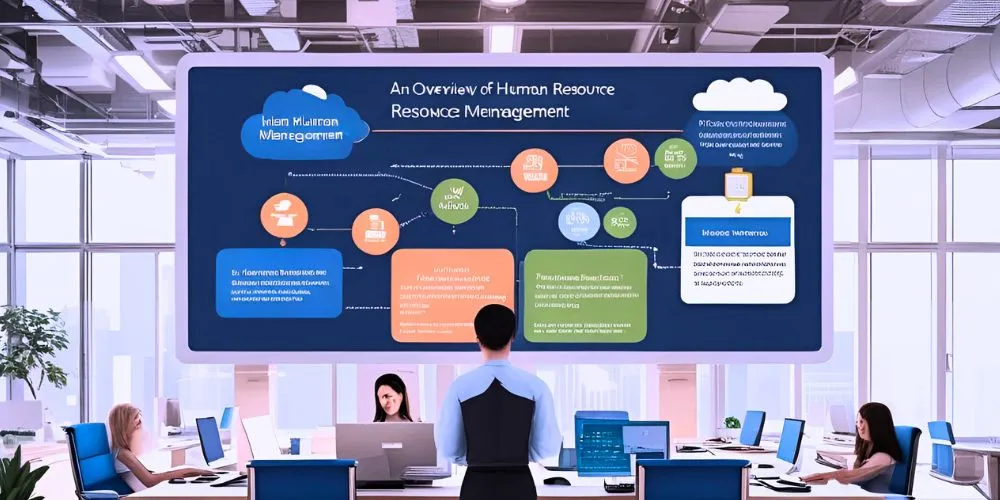Human Resource Management (HRM) is a crucial function that focuses on managing the organization’s most valuable asset—its people. The HRM process encompasses a wide range of activities and practices aimed at attracting, developing, and retaining a talented workforce. This article provides an overview of the HRM process, its key components, and its significance in driving organizational success.
Understanding the HRM Process
The HRM process is a systematic approach to managing human resources within an organization. It involves several interconnected stages supporting the organization’s human capital needs. While specific practices may vary between organizations, the fundamental components of the HRM process include the following.
- Human Resource Planning: This stage involves forecasting the organization’s future human resource needs in terms of quantity and quality. HR professionals analyze current workforce capabilities, identify gaps, and develop strategies to ensure the organization has the right people with the right skills at the right time.
- Recruitment and Selection: Once the workforce needs are identified, HR professionals engage in activities to attract, evaluate, and select qualified candidates. It may involve sourcing candidates through various channels, conducting interviews and assessments, and making the final hiring decisions.
- Onboarding and Orientation: After candidates are hired, the onboarding process begins. This stage involves introducing new employees to the organization, its culture, policies, and procedures. Effective onboarding helps new hires acclimate quickly, understand their roles, and become productive members of the organization.
- Training and Development: Continuous learning and development are crucial for employee growth and organizational success. HR professionals design and implement training programs to enhance employees’ skills, knowledge, and capabilities. These programs may include orientation sessions, technical training, leadership development, and performance improvement initiatives.
- Performance Management: Performance management involves setting goals, providing feedback, and evaluating employee performance. HR professionals work with managers to establish performance metrics, conduct regular performance reviews, and provide coaching and support to help employees reach their full potential.
- Compensation and Benefits: HR professionals are central in developing and administering compensation and benefits programs. They ensure that employees are fairly rewarded for their contributions through competitive salaries, bonuses, incentives, and comprehensive benefits packages.
- Employee Relations: Maintaining positive employee relations is essential for a harmonious work environment. HR professionals handle employee grievances, mediate conflicts, and foster effective communication between employees and management. They also promote employee engagement initiatives to boost morale and job satisfaction.
- Employee Retention: Retaining top talent is a priority for organizations. HR professionals implement strategies to enhance employee satisfaction, improve work-life balance, and create opportunities for career advancement. They conduct exit interviews and gather feedback to identify areas for improvement and address employee concerns.
The Significance of the HRM Process
The HRM process plays a crucial role in organizational success. Here are some key reasons why it is significant.
- Strategic Alignment: The HRM process aligns human resource strategies with the organization’s goals and objectives. It ensures that the workforce has the right skills and competencies to drive organizational success.
- Talent Acquisition and Retention: Effective recruitment and selection practices and robust retention strategies help organizations attract and retain top talent. This ensures a high-performing workforce capable of meeting organizational objectives.
- Employee Development: By investing in employee training and development, organizations enhance employee skills, competencies, and job satisfaction. It contributes to higher productivity, improved employee engagement, and long-term retention.
- Performance Improvement: The HRM process supports performance management initiatives that enable managers to set clear expectations, provide feedback, and recognize employee achievements. It drives individual and team performance, leading to organizational success.
- Compliance and Legal Requirements: HR professionals ensure compliance with employment laws, regulations, and labor practices. They stay updated with legal changes, maintain accurate employee records, and promote fair and ethical employment practices.
- Organizational Culture: The HRM process plays a significant role in shaping the corporate culture. HR professionals contribute to a culture of collaboration, innovation, and excellence through effective communication, employee engagement initiatives, and fostering a positive work environment.
- Change Management: HR professionals are instrumental in managing organizational change. They facilitate smooth transitions, communicate change initiatives, and support employees through periods of change and uncertainty.
Conclusion
The HRM process is a comprehensive framework that supports the effective management of human resources within organizations. Each process stage contributes to organizational success, from planning and recruitment to development, performance management, and retention. HR professionals are critical in driving corporate growth, productivity, and competitiveness by aligning human resource strategies with business objectives, attracting and retaining top talent, promoting employee development, and ensuring compliance.













